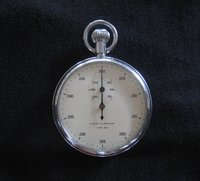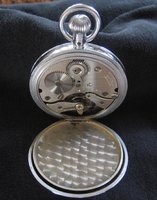Another one that baffles me: I collect stopwatches that are either unusual, rare, 'purpose built' or a combination thereof.
I have several super high BPH beats per hour) timers. They're fascinating to watch the sweep hand zip around the dial. Several had specific WWII military uses. (The WWII A-8 (jitterbug) USAAF groundspeed timer or the Soviet Agat Sonar timer or the magnificent Soviet 2nd Watch Factory (now Slava) 1/100th of a second stopwatch that went into space mounted in the capsule's of the original Soviet Cosmonauts.)
But this little speedster I recently acquired has me stumped. A revolution of the sweep hand take only 2 seconds. As you can see the outer register has 50 indices, numbered every five, beginning with .005 .010 .015 etc. ending at .050 (the full 2 second revolution). The accumulator dial register has 40 indices numbered every 5 beginning with .250 .500 .750 1000 etc. and ending with 2
Mathematics is not my strength (that's putting it mildly). Can anyone explain what is being timed? Decimals of seconds?
If so, why accumulate in .050 segments ending at 2 (after 40 rotations - 80 seconds)
If any one here can offer any explanations (about the math), or, speculate on possible uses, military or industrial) I'd be both grateful and interested in learning.


I have several super high BPH beats per hour) timers. They're fascinating to watch the sweep hand zip around the dial. Several had specific WWII military uses. (The WWII A-8 (jitterbug) USAAF groundspeed timer or the Soviet Agat Sonar timer or the magnificent Soviet 2nd Watch Factory (now Slava) 1/100th of a second stopwatch that went into space mounted in the capsule's of the original Soviet Cosmonauts.)
But this little speedster I recently acquired has me stumped. A revolution of the sweep hand take only 2 seconds. As you can see the outer register has 50 indices, numbered every five, beginning with .005 .010 .015 etc. ending at .050 (the full 2 second revolution). The accumulator dial register has 40 indices numbered every 5 beginning with .250 .500 .750 1000 etc. and ending with 2
Mathematics is not my strength (that's putting it mildly). Can anyone explain what is being timed? Decimals of seconds?
If so, why accumulate in .050 segments ending at 2 (after 40 rotations - 80 seconds)
If any one here can offer any explanations (about the math), or, speculate on possible uses, military or industrial) I'd be both grateful and interested in learning.


